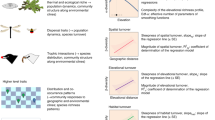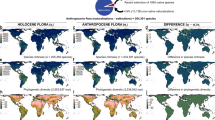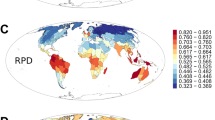Abstract
How and why organisms are distributed as they are has long intrigued evolutionary biologists1,2,3,4. The tendency for species to retain their ancestral ecology has been demonstrated in distributions on local and regional scales5,6,7, but the extent of ecological conservatism over tens of millions of years and across continents has not been assessed8,9,10,11,12,13. Here we show that biome stasis at speciation has outweighed biome shifts by a ratio of more than 25:1, by inferring ancestral biomes for an ecologically diverse sample of more than 11,000 plant species from around the Southern Hemisphere. Stasis was also prevalent in transocean colonizations. Availability of a suitable biome could have substantially influenced which lineages establish on more than one landmass, in addition to the influence of the rarity of the dispersal events themselves. Conversely, the taxonomic composition of biomes has probably been strongly influenced by the rarity of species’ transitions between biomes. This study has implications for the future because if clades have inherently limited capacity to shift biomes13, then their evolutionary potential could be strongly compromised by biome contraction as climate changes.
This is a preview of subscription content, access via your institution
Access options
Subscribe to this journal
Receive 51 print issues and online access
$199.00 per year
only $3.90 per issue
Buy this article
- Purchase on Springer Link
- Instant access to full article PDF
Prices may be subject to local taxes which are calculated during checkout


Similar content being viewed by others
References
Darwin, C. Does sea-water kill seeds? Garden. Chron. 21, 356–357 (1855)
Raven, P. H. & Axelrod, D. I. Angiosperm biogeography and past continental movements. Ann. MO Bot. Gard. 61, 539–673 (1974)
Hallam, A. An Outline of Phanerozoic Biogeography (Oxford Univ. Press, 1994)
Humphries, C. J. & Parenti, L. Cladistic Biogeography (Oxford Univ. Press, 1999)
Losos, J. B. et al. Niche lability in the evolution of a Caribbean lizard community. Nature 424, 542–545 (2003)
Ackerly, D. D., Schwilk, D. W. & Webb, C. O. Niche evolution and adaptive radiation: testing the order of trait divergence. Ecology 87, S50–S61 (2006)
Silvertown, J. et al. Absence of phylogenetic signal in the niche structure of meadow plant communities. Proc. R. Soc. Lond. B 273, 39–44 (2006)
Prinzing, A., Durka, W., Klotz, S. & Brandl, R. The niche of higher plants: evidence for phylogenetic conservatism. Proc. R. Soc. Lond. B 268, 2383–2389 (2001)
Svenning, J. C. Deterministic Plio-Pleistocene extinctions in the European cool-temperate tree flora. Ecol. Lett. 6, 646–653 (2003)
Qian, H. & Ricklefs, R. E. Geographical distribution and ecological conservatism of disjunct genera of vascular plants in eastern Asia and eastern North America. J. Ecol. 92, 253–265 (2004)
Wiens, J. J. & Graham, C. H. Niche conservatism: integrating evolution, ecology, and conservation biology. Annu. Rev. Ecol. Evol. Syst. 36, 519–539 (2005)
Ricklefs, R. E. History and diversity: explorations at the intersection of ecology and evolution. Am. Nat. 170 (suppl.), 56–70 (2007)
Losos, J. B. Phylogenetic niche conservatism, phylogenetic signal and the relationship between phylogenetic relatedness and ecological similarity among species. Ecol. Lett. 11, 995–1003 (2008)
Peterson, A. T., Soberon, J. & Sanchez-Cordero, V. Conservatism of ecological niches in evolutionary time. Science 285, 1265–1267 (1999)
Pearman, P. B., Guisan, A., Broennimann, O. & Randin, C. F. Niche dynamics in space and time. Trends Ecol. Evol. 23, 149–158 (2008)
Woodward, F. I., Lomas, M. R. & Kelly, C. K. Global climate and the distribution of plant biomes. Phil. Trans. R. Soc. Lond. B 359, 1465–1476 (2004)
Wiens, J. J. & Donoghue, M. J. Historical biogeography, ecology and species richness. Trends Ecol. Evol. 19, 639–644 (2004)
Crisp, M. D. Biome assembly: what we know and what we need to know. J. Biogeogr. 33, 1332–1333 (2006)
Linder, H. P. & Crisp, M. D. Nothofagus and Pacific biogeography. Cladistics 11, 5–32 (1995)
Sanmartín, I. & Ronquist, F. Southern Hemisphere biogeography inferred by event-based models: plant versus animal patterns. Syst. Biol. 53, 216–243 (2004)
de Queiroz, A. The resurrection of oceanic dispersal in historical biogeography. Trends Ecol. Evol. 20, 68–73 (2005)
Hill, R. S. Origins of the southeastern Australian vegetation. Phil. Trans. R. Soc. Lond. B 359, 1537–1549 (2004)
Stromberg, C. A. E. Decoupled taxonomic radiation and ecological expansion of open-habitat grasses in the Cenozoic of North America. Proc. Natl Acad. Sci. USA 102, 11980–11984 (2005)
Crisp, M., Cook, L. G. & Steane, D. A. Radiation of the Australian flora: what can comparisons of molecular phylogenies across multiple taxa tell us about the evolution of diversity in present-day communities? Phil. Trans. R. Soc. Lond. B 359, 1551–1571 (2004)
Alsos, I. G. et al. Frequent long-distance plant colonization in the changing Arctic. Science 316, 1606–1609 (2007)
Thuiller, W. et al. Niche-based modelling as a tool for predicting the risk of alien plant invasions at a global scale. Glob. Change Biol. 11, 2234–2250 (2005)
Peterson, A. T. Predicting the geography of species' invasions via ecological niche modeling. Q. Rev. Biol. 78, 419–433 (2003)
Orians, G. H. & Milewski, A. V. Ecology of Australia: the effects of nutrient-poor soils and intense fires. Biol. Rev. Camb. Phil. Soc. 82, 393–423 (2007)
Burgoyne, P. M., van Wyk, A. E., Anderson, J. M. & Schrire, B. D. Phanerozoic evolution of plants on the African plate. J. Afr. Earth Sci. 43, 13–52 (2005)
Barreda, V. & Palazzesi, L. Patagonian vegetation turnovers during the Paleogene-early Neogene: Origin of arid-adapted floras. Bot. Rev. 73, 31–50 (2007)
Maddison, W. P. & Maddison, D. R. MESQUITE: A modular system for evolutionary analysis. Mesquite 〈http://mesquiteproject.org〉 (version 2.01, 2007)
Omland, K. E., Cook, L. G. & Crisp, M. D. Tree thinking for all biology: the problem with reading phylogenies as ladders of progress. Bioessays 30, 854–867 (2008)
Cook, L. G. & Crisp, M. D. Directional asymmetry of long-distance dispersal and colonisation could mislead reconstructions of biogeography. J. Biogeogr. 32, 741–754 (2005)
Lewis, P. O. A likelihood approach to estimating phylogeny from discrete morphological character data. Syst. Biol. 50, 913–925 (2001)
Crepet, W. L., Nixon, K. C. & Gandolfo, M. A. Fossil evidence and phylogeny: the age of major angiosperm clades based on mesofossil and macrofossil evidence from Cretaceous deposits. Am. J. Bot. 91, 1666–1682 (2004)
McLoughlin, S. The breakup history of Gondwana and its impact on pre- Cenozoic floristic provincialism. Aust. J. Bot. 49, 271–300 (2001)
Cook, L. G. & Crisp, M. D. Not so ancient: the extant crown group of Nothofagus represents a post-Gondwanan radiation. Proc. R. Soc. Lond. B 272, 2535–2544 (2005)
Ladiges, P. Y. & Cantrill, D. New Caledonia-Australian connections: biogeographic patterns and geology. Aust. Syst. Bot. 20, 383–389 (2007)
Acknowledgements
We thank the Australian Research Council-New Zealand Research Network for Vegetation Function for facilitating this collaboration. Participation by M.A.G. and P.W. was supported in part by a grant from the US National Science Foundation.
Author Contributions All authors participated in two workshops where the phylogenetic and biome data were initially compiled. All authors participated in analysis and interpretation at the workshops and subsequently by email. M.W. designed and facilitated the study. M.A.G., G.J.J. and P.W. provided palaeobotanical dates. M.D.C. drafted the paper in collaboration with H.P.L., and provided supplementary statistical analyses during review.
Author information
Authors and Affiliations
Corresponding author
Supplementary information
Supplementary Information
This file contains Supplementary Results, Supplementary Figures 1-2 with Legends, Supplementary Tables 1-6 and Supplementary References (PDF 493 kb)
PowerPoint slides
Rights and permissions
About this article
Cite this article
Crisp, M., Arroyo, M., Cook, L. et al. Phylogenetic biome conservatism on a global scale. Nature 458, 754–756 (2009). https://doi.org/10.1038/nature07764
Received:
Accepted:
Published:
Issue Date:
DOI: https://doi.org/10.1038/nature07764
This article is cited by
-
The geno-geo-climate nexus: contributions of geographic and ecological factors in shaping the genomic divergence of two closely related threatened rainforest species of Fontainea Heckel (Euphorbiaceae)
Landscape Ecology (2024)
-
Attributes of host-specificity better explain the diversified wood-boring longhorn beetles in tropical SW China than plant species diversity
Scientific Reports (2023)
-
Integrating remote sensing with ecology and evolution to advance biodiversity conservation
Nature Ecology & Evolution (2022)
-
Family legacy: contrasting diversity–elevation relationships on a coastal Atlantic Forest mountain system
Plant Ecology (2022)
-
Out of New Guinea? Two new species of Zygogynum (Winteraceae) extend the genus west of Lydekker’s and Wallace’s Lines
Kew Bulletin (2022)
Comments
By submitting a comment you agree to abide by our Terms and Community Guidelines. If you find something abusive or that does not comply with our terms or guidelines please flag it as inappropriate.



